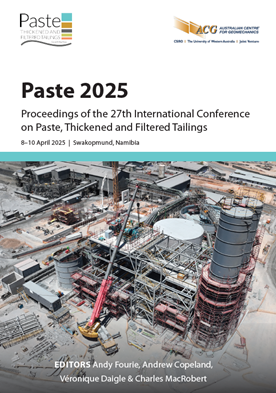Enabling dry stack tailings disposal through enhanced vacuum belt filtration

|
Authors: Wait, S; Cooper, L |
DOI https://doi.org/10.36487/ACG_repo/2555_45
Cite As:
Wait, S & Cooper, L 2025, 'Enabling dry stack tailings disposal through enhanced vacuum belt filtration', in AB Fourie, A Copeland, V Daigle & C MacRobert (eds), Paste 2025: Proceedings of the 27th International Conference on Paste, Thickened and Filtered Tailings, Australian Centre for Geomechanics, Perth, pp. 627-640, https://doi.org/10.36487/ACG_repo/2555_45
Abstract:
Investigation into, and uptake of, filtered tailings continues to grow throughout the globe. This is driven by a wide range of site-specific considerations including such factors as tailings characteristics (amenability to filtration), production rates, climate, water availability, cost drivers, environmental requirements and regulations, and social factors. With consideration of the costs for development and maintenance of wet tailings storage facilities, and mine rehabilitation plans, dry stacking of tailings material is increasingly becoming the preferred method of mine waste disposal. Despite the increase in demand for dry stacking, the currently available filtration technology is not able to economically meet the needs of many operations and projects that would otherwise adopt the technology. Due to the moisture content limitation for dry stacking, most processes require high energy filtration such as pressure filters over vacuum filtration technology. The main deterrent for many mining operations in utilising pressure filtration becomes the significant upfront and ongoing costs associated with the required infrastructure and equipment maintenance. To bridge the gap in the filtered tailings moisture content between pressure filtration and vacuum belt filtration, Jord has developed and patented Viper technology. Viper technology has now been incorporated into a modular, retrofittable product which has proven to enhance the processing capabilities of conventional vacuum belt filters, and achieve tailings moisture contents comparable to those of pressure filters. This unlocks the potential for a dry stack tailings plant without the increased costs of operation and maintenance associated with a pressure filter facility. The Viper consists of a roller and exciter coupled with instrumentation and logic for automatic control. The roller sits on the filter cake and transmits a vibration energy into the process, leveraging the thixotropic properties of the material. This process, also known as shear thinning, reduces the viscosity of the slurry through release of the entrained liquid. This liquid is then readily removed under the vacuum pressure while the solid matter consolidates with less porosity, providing a significant step change in the final moisture content. Jord has numerous operating references for Viper technology at large-scale vacuum belt dewatering facilities, for both concentrate and tailings filtration.
Keywords: filtration, innovation, tailings disposal, thixotropic, environment
References:
Atkins, PW 1992, The Elements of Physical Chemistry, Oxford University Press, Oxford.
Batchelor, GK 1967, An Introduction to Fluid Dynamics, Cambridge University Press, Cambridge.
Whatnall, O, Barber, K & P Robinson, P 2021, ‘Tailings filtration using viper filtration technology – a case study’, Mining, Metallurgy & Exploration, vol 38, pp. 1297–1303.
Whatnall, O, Santander, R Wilson, S & Caldwell, S 2024, Game-changing technology for large scale filtered tailings, Proceedings of Tailings and Mine Waste 2024, Colorado State University, Fort Collins, University of British Columbia, Vancouver, and the University of Alberta, Edmonton.
© Copyright 2025, Australian Centre for Geomechanics (ACG), The University of Western Australia. All rights reserved.
View copyright/legal information
Please direct any queries or error reports to repository-acg@uwa.edu.au
View copyright/legal information
Please direct any queries or error reports to repository-acg@uwa.edu.au
